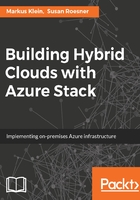
Microsoft Azure Stack
In May 2015, Microsoft formally announced a new solution that brings Azure to your datacenter. This solution was named Microsoft Azure Stack. To put it in one sentence: Azure Stack is the same technology with the same APIs and portal as public Azure, but you could run it in your datacenter or in that of your service providers. With Azure Stack, System Center is completely gone because everything is the way it is in Azure now, and in Azure, there is no System Center at all. This is what the primary focus of this book is.
The following diagram gives a current overview of the technical design of Azure Stack compared with Azure:

The one and only difference between Microsoft Azure Stack and Microsoft Azure is the Cloud infrastructure. In Azure, there are thousands of servers that are part of the solution; with Azure Stack, the number is slightly smaller. That's why there is the Cloud-inspired infrastructure based on Windows Server, Hyper-V, and Azure technologies as the underlying technology stack. There is no System Center product in this stack anymore. This does not mean that it cannot be there (for example, SCOM for on-premise monitoring), but Azure Stack itself provides all functionality with the solution itself.
For stability and functionality, Microsoft decided to provide Azure Stack as a so-called integrated system, so it will come to your door with the hardware stack included. The customer buys Azure Stack as a complete technology stack. At the general availability (GA) stage, the hardware OEMs are HPE, Dell EMC, and Lenovo. In addition to this, there will be a one-host development toolkit available for download that could be run as a proof of concept solution on every type of hardware, as soon as it meets the hardware requirements.